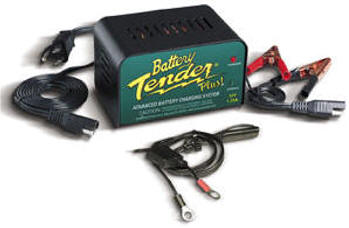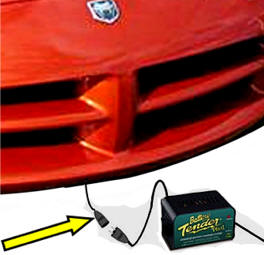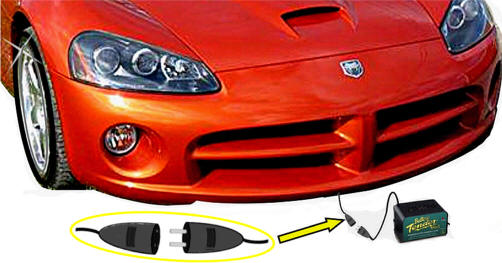|
This Frame has opened up into
a New Window
DODGE VIPER 1992-2006
Battery Charger & Tender PLUS
PICTURES and Information
|
Battery Tender PLUS©
Device
Details |
|

|
Product Details
Battery Tender PLUS is lightweight, compact size makes it ideal for those hard-to-fit
spots. The trickled charger with a brain will assure batteries are maintained
after charging and allows ready to go!
-
Fully automatic two-stage
lead-acid battery charger. Perfect for all lead-acid, sealed maintenance free
and gel cell batteries.
-
SuperSmartô
Charging Technology.
-
After reaching peak 14.4 VDC,
charger automatically switches to 13.2 VDC float voltage.
-
When voltage drops below 12.6 VDC,
charger resumes charging back to 14.4 VDC.
-
Solid state two color LED
indicates stage of charger.
-
Spark proof.
-
Reverse polarity protected.
-
12' output cord.
-
5 year warranty.
-
3-Step Charging (Initialization,
Bulk, Float)
-
Short Circuit Protected.
|
 You will never have a dead or
weak battery because your car was sitting too long!
Back to
Top of Page - Click Here ▲ |

It's so EASY! The connector cord and female
connector head simply connect to your battery and stay connected. Plug it
in to the charger connector and keep it plugged in for a constant trickle
charge. It will only come on when your battery starts to get low. When not
in use it simply tuck the connector cord (yellow Arrow) up inside the engine
compartment. Start your car and drive away. You never have to open
the hood. |
|
1. How can I tell if my
battery is charged or not?
Lead acid batteries are made up of cells. Each cell is approximately 2
volts, so a 12-volt battery has 6 individual cells. It turns out that a
fully charged 2-volt cell has a voltage of approximately 2.15 volts. Oddly
enough, a fully discharged 2-volt cell has a voltage of 1.9 volts. Thatís
only a difference of 0.25 volts on each cell from fully charged to fully
discharged. So a 12-volt battery will measure at about 12.9 volts when itís
fully charged and about 11.4 volts when it is fully discharged. Thatís a
total of 1.5 volts that represents the full range of charge on a 12-volt
battery. To make a good guess at how much charge your battery has left, you
can assign a percentage of charge remaining that is directly proportional to
the battery voltage. Letís see how we can do that. If the battery voltage is
12.15 volts, how much charge is left? Beginning with 11.4 volts representing
no charge or 0% charge available, subtract 11.4 volts from the voltage that
you read. So 12.15 Ė 11.4 = 0.75 volts. Since there are only 1.5 volts above
11.4 volts that represents the full range of charge, we can divide the
difference that we just calculated by 1.5 volts to get the percentage of
charge remaining. 0.75 volts / 1.5 volts = 0.5 or when expressed as a
percentage, multiply by 100 and get 50%. Hereís the procedure written as a
formula that is applicable to 12 Volt Batteries:
OPEN CIRCUIT BATTERY STATE OF CHARGE CALCULATION
% Charge = SOC
% Charge = ((Measured Battery Voltage Ė 11.4 volts) / 1.5 volts) x 100
Equation 1
That seems easy enough. So whatís the catch? In order for this formula to
work, the battery must be in a rest state. In other words, the battery
should not be supplying power to any type of load. The experts say that the
battery should remain at rest for at least 24 hours to get an accurate
measurement, but in a pinch a couple of hours are good enough to make a
reasonable guess. Even if the battery is connected to a load, as long as the
load current is less than 1% of the battery capacity in amp-hours, then this
method is probably good enough in most cases. Itís all a matter of how
accurate you want to be. If youíre a scientist or engineer trying to develop
a battery powered product, then you probably want a more accurate
measurement than if youíre going fishing for the weekend and you just want
to know if you need to take the time to charge your battery before you use
it. There is one more thing to keep in mind. The only way to be absolutely
sure that your battery is fully charged is to do a load test. It is best to
have the battery dealer do this for you. We only mention it here because it
is possible for a battery to indicate a good voltage, but then immediately
when you try to use it, it acts like itís dead. This doesnít happen very
often, but itís good to know that it is a possibility.
Back to
Top of Page - Click Here ▲ |
|
2. How long will it
take to charge a battery?
We can make a pretty good guess by just dividing two numbers:
Approximate Recharge Time Calculations
(Battery Capacity) / (Charger Current) = Hours
(Amp-Hours) / (Amps) = Hours
Equation 2
Suppose I have a 50 Amp-Hour battery. Thatís a fairly typical size for an
automotive engine start type battery. Now letís say I have a 10 Amp charger.
(50 Amp-Hours) divided by (10 Amps) = 5 Hours. So we would estimate that it
will take a good 10 Amp charger about 5 Hours to recharge a 50 Amp-Hour
battery. Actually this rough estimate usually tells us how long it takes to
recharge the battery to about 80% of its capacity. To complete the recharge
of a battery to 100% with a 3-step charger, it turns out that it will
probably take an equal amount of time, or another 5 hours to recharge the
last 20% of the battery capacity. To complete the recharge of a battery to
100% with a 4 step charger, in most cases it will take less time than with a
3 Step Charger to recharge the last 20% of the battery capacity. These times
are different for all of the software versions.
Back to
Top of Page - Click Here ▲ |
3. Is the Battery Tender
PLUS battery
charger more expensive than a trickle charger?
The Battery Tender
PLUS Device will do a much better job in maintaining the
charge on a battery than a typical trickle charger. The Battery Tender
PLUS Device will provide more long-term value and hence a significant improvement
in the total cost of ownership. The initial price may be higher than trickle
chargers with comparable output power capability, but like the ad says, "The
Battery Tender Device is like a trickle charger with a brain." That added
measure of on-board intelligence provides the means for the Battery Tender
PLUS Device to more safely and effectively maintain the charge on a battery much
larger than its competitorís in the same power range. A trickle charger
simply cannot regulate its output voltage to consistently safe levels over
extended periods of time as the battery characteristics change.
Back to Top of Page - Click Here ▲ |
4. How is the Battery Tender
PLUS Device
battery charger different from a trickle charger?
The Battery Tender
PLUS
Device employs a higher level of sophistication in its
use of electronic control to maintain a battery in a full state of charge
over extended periods of time. The Battery Tender
PLUS Device employs a charge
control method to keep the battery at full charge while minimizing the
long-term risk of overcharge and premature capacity loss. Trickle chargers
are simply not capable of regulating the output voltage applied to a battery
as the battery ages, or if a different battery with different
characteristics is connected to the trickle chargerís output terminals. The
Battery Tender PLUS Device is capable of charge maintenance on all lead acid
battery types, including both AGM and GEL cells.
Back to
Top of Page - Click Here ▲ |
This Frame has opened up into a New Window
|
![]()

